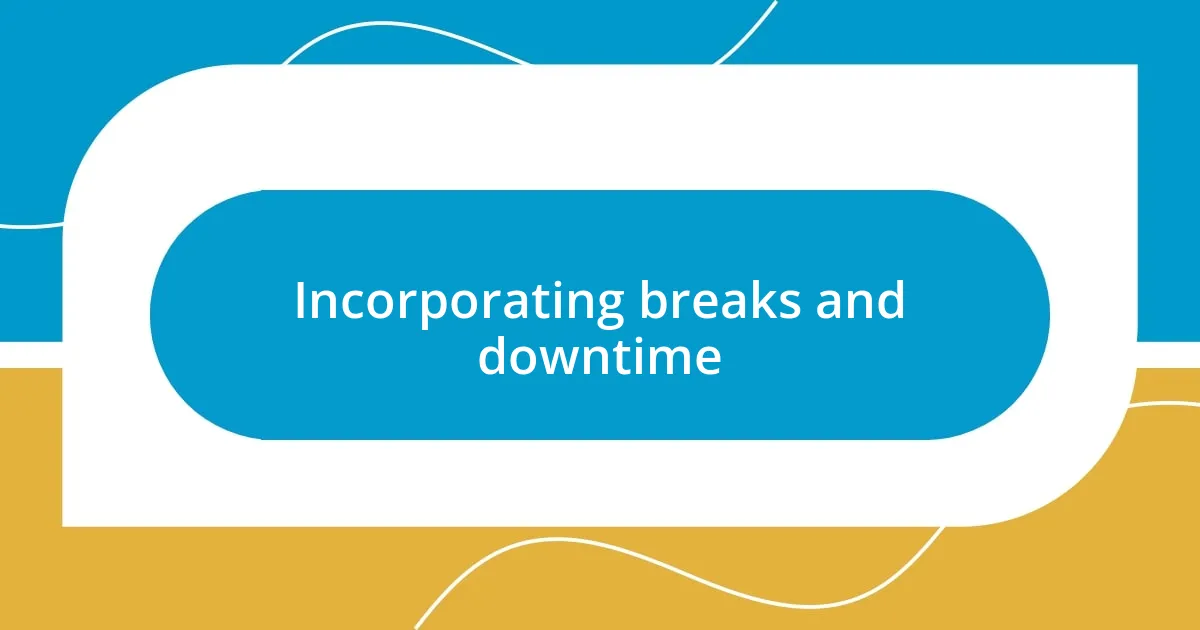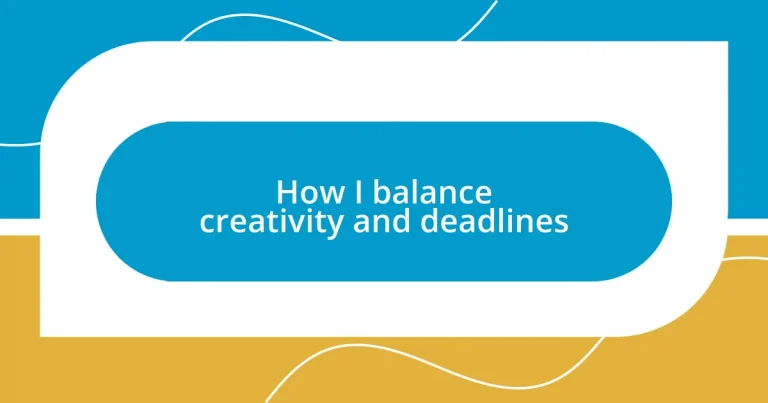Key takeaways:
- Creativity and deadlines can coexist harmoniously by viewing deadlines as structures that guide rather than restrict creative flow.
- Identifying personal creative triggers, such as environment and emotional state, enhances productivity and inspiration.
- Setting realistic deadlines and breaking down tasks reduces overwhelm, allowing for a more focused and enjoyable creative process.
- Incorporating breaks and varying workspaces can rejuvenate creativity and maintain motivation during project timelines.

Understanding creativity and deadlines
Creativity often thrives in a space where ideas can roam freely, unencumbered by the ticking clock. I remember a time when I was brainstorming a project and, instead of focusing on the deadline, I let my thoughts flow; it felt liberating. But as the deadline loomed closer, I found myself grappling with the tension between my creative impulses and the necessity to produce something tangible.
Deadlines can feel like a daunting wall, challenging my creative spirit. Have you ever felt that pulse of anxiety as the due date approaches? I recall frantically revising my work at the last minute, all while wishing I had allowed myself more time to explore different ideas. This rush, while at times validating, often robs creativity of its depth and richness.
It’s essential to recognize that creativity and deadlines don’t have to be adversaries. I’ve learned to view deadlines as a structure that can channel inspiration rather than restrict it. By allocating time to brainstorm without limits, then transitioning into focused work periods, I strike a balance that nurtures my creativity while still meeting expectations. How do you approach this balance in your projects?

Identifying personal creative triggers
Identifying my creative triggers has been a game-changer in how I approach projects. For instance, I’ve realized that a quiet morning, with a warm cup of coffee in hand, often sparks my most innovative ideas. It’s fascinating how the environment around me can shift my mindset, turning an ordinary moment into a flood of inspiration. Understanding what ignites my creativity allows me to better plan my work sessions.
To uncover your own creative triggers, consider these aspects:
- Environment: Is there a specific place where you feel most inspired?
- Emotional State: Are you more creative when you’re happy, relaxed, or even a bit stressed?
- Time of Day: Do you find your best ideas come in the morning, afternoon, or late at night?
- Activities: What hobbies or activities seem to ignite your imagination?
- People: Does being around certain individuals stimulate your creative thought?
By reflecting on these points, you can create conditions that nurture your creativity while still adhering to deadlines.

Setting realistic deadlines
Setting realistic deadlines is crucial to maintaining that delicate balance between creativity and productivity. From my experience, I’ve found that breaking down larger projects into smaller, manageable tasks can make the process feel less overwhelming. When I first started doing this, I noticed a shift in my mindset; instead of viewing deadlines as an enemy, they became stepping stones toward achieving a larger goal.
I remember a project where I set a deadline for each part of the process, allocating specific time for brainstorming, drafting, and revising. This method allowed me to breathe a little easier because I was able to focus on one task at a time. It felt liberating to know I wasn’t rushing through every phase but instead giving each part the attention it deserved. This way, I could enjoy the creative journey without the anxiety that usually accompanies tight deadlines.
Setting realistic deadlines also involves being honest about my limitations. I’ve had days when inspiration didn’t strike, and I realized that my expectations for myself needed to be adjusted. It’s okay to adapt and change timelines based on how I’m feeling or the complexity of the task. When I embrace this flexibility, I notice that my creativity flourishes, and the end result turns out to be much more satisfying and true to my vision.
| Approach | Description |
|---|---|
| Breaking Down Tasks | Dividing projects into smaller, manageable tasks helps to reduce overwhelm. |
| Setting Specific Timeframes | Allocating time for each stage of a project ensures focus and prevents last-minute rush. |
| Being Flexible | Adjusting deadlines based on mood and complexity allows for a more nurturing creative process. |

Prioritizing tasks effectively
One of the most effective strategies I’ve found for prioritizing tasks is creating a visual representation of my workload. I often use tools like Trello or even a simple to-do list on paper. As I write each task down, I can feel my mind declutter. It’s almost like lifting a weight off my shoulders. I categorize these tasks based on urgency and importance, which allows me to see at a glance where my focus should be. Do I tackle that looming deadline first, or do I nurture my creativity with a brainstorming session? Choosing the right starting point makes all the difference.
During a particularly busy week, I encountered a project with overlapping deadlines. I decided to create a matrix to help me decide. I mapped out my tasks based on urgency and importance and was surprised to see how many tasks didn’t actually require my immediate attention. It felt immensely freeing to recognize that I didn’t have to juggle everything at once. By prioritizing effectively, I was able to devote quality time to the more significant projects, which, in turn, sparked my creativity. It’s a reminder that not everything has the same weight; sometimes letting go is just as important as diving in.
Another thing I’ve learned is the power of setting aside specific blocks of time to focus on high-priority tasks without distractions. I remember a time when I decided to turn off my notifications and close my email for a couple of hours. Giving myself that dedicated space created a bubble of productivity. I could pour my energy into one project, allowing my creative thoughts to flow freely. I ask myself: what would happen if we all set clear priorities and protected our time? I believe we’d discover a richer, more enjoyable creative process. It’s about making choices that honor both deadlines and the creative spark within us.

Incorporating breaks and downtime
Taking breaks and ensuring downtime is something I’ve come to value greatly in my routine. I recall a particularly intense period when I was pushing hard to meet multiple deadlines. There was a moment when I finally stepped away from my desk and went for a walk. That simple act, breathing in fresh air and changing my environment, sparked ideas that had been stuck in my mind. It’s incredible how even a short break can provide a reset, allowing creativity to flow rather than feeling stifled.
Scheduling breaks is not just about stepping away; it’s about recharging my mental energy. I’ve experimented with the Pomodoro technique, working for 25 minutes followed by a five-minute break. Initially, I was skeptical, thinking I would lose momentum. But each break actually sharpened my focus, improving my work quality and keeping the sense of pressure at bay. Wouldn’t it be fantastic if everyone embraced the idea that a pause is just as valuable as productivity? I truly believe it is.
One of my favorite practices is indulging in downtime with a creative hobby unrelated to my work. I often find myself sketching or playing my guitar for a bit during lunch breaks. This little indulgence reminds me that creativity isn’t confined to deadlines; it’s a broader spectrum of expression. By incorporating these moments of joy into my day, I reconnect with my own creative instincts, which ultimately enhances my work when I return to it. It’s all a part of nurturing that creative spirit, reminding myself that it’s okay to step away.

Techniques for staying motivated
Finding motivation can sometimes feel elusive, but I’ve discovered some techniques that really keep my creative juices flowing. One method I love is changing my workspace regularly. I remember a time when I became unproductive simply because I’d been glued to my desk for too long. I decided to move to a cozy corner of my living room with a warm cup of tea. That shift in environment revitalized my thoughts and sparked new creativity. So, have you ever considered that a simple change of scenery could impact your motivation?
Setting inspiring goals is another technique I swear by. What if I told you that instead of just focusing on deadlines, I outline exciting milestones? For instance, during a recent project, I envisioned not just completion but also the joy of sharing my work with an audience. By placing more emphasis on the excitement of the end result, I found myself naturally motivated to tackle each task. Isn’t it amazing how a shift in perspective can make the grind feel like an adventure?
Finally, I wholeheartedly believe in the power of community. I often connect with fellow creatives—be it through online forums or local meetups. Just the other week, I attended a small workshop where we all shared our projects. I left feeling energized and inspired, not just by their ideas but by the support we offered one another. So, have you reached out to someone about your creative journey lately? Engaging with others can reignite that passionate fire even when deadlines loom closely.

Reviewing and adjusting your process
As I reflect on my creative process, I’ve learned that regular reviews are vital. I like to schedule a “reflection day” at the end of each project, where I analyze what strategies worked and which didn’t. There was a project where I thought my original outline was perfect, but halfway through, I realized it lacked depth. This reassessment allowed me to pivot and explore new angles, ultimately enriching the final piece. Have you ever found that stepping back reveals insights you’d missed in the heat of the moment?
Adjusting my process isn’t just about recognizing failures; it’s an ongoing practice of tuning into my creative rhythms. Sometimes, I notice my productivity dips during particular times of the day or in certain environments. For instance, I’ve noticed that I tend to be more innovative in the mornings. I make it a point to harness that energy by tackling the most challenging tasks first. Isn’t it remarkable how simply paying attention to these patterns can transform how we approach our work?
Additionally, I’ve found that collaborating with others is an enlightening way to adjust my process. Sharing my workflow with a trusted colleague can prompt fresh perspectives. I recall a brainstorming session where we dissected each other’s approaches. It was eye-opening! We not only grew from each other’s knowledge but also adapted tactics that we found effective. Have you tried bouncing ideas off someone? I truly believe that collaboration fuels growth and can lead to unexpected breakthroughs in our creative endeavors.














